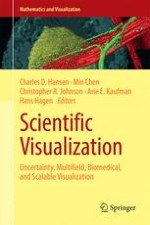2014 | OriginalPaper | Chapter
9. Mathematical Foundations of Uncertain Field Visualization
Authors : Gerik Scheuermann, Mario Hlawitschka, Christoph Garth, Hans Hagen
Published in: Scientific Visualization
Publisher: Springer London
Activate our intelligent search to find suitable subject content or patents.
Select sections of text to find matching patents with Artificial Intelligence. powered by
Select sections of text to find additional relevant content using AI-assisted search. powered by
